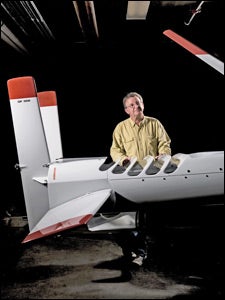THERE IS A STORY THAT engineer Graham Hawkes tells to explain why he began building strange winged submarines, and it takes place, quite naturally, in a cloud of muck on the seafloor.
Hawkes at Hawkes Ocean Technologies
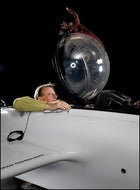 Hawkes at Hawkes Ocean Technologies, Point Richmond, California
Hawkes at Hawkes Ocean Technologies, Point Richmond, CaliforniaThe Super Falcon
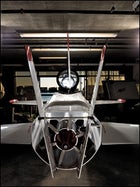 The Super Falcon
The Super FalconThe Super Falcon
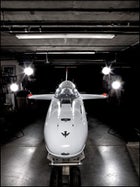 The Super Falcon
The Super FalconHawkes with the Super Falcon
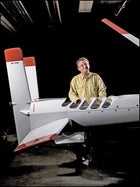 Hawkes with the Super Falcon
Hawkes with the Super FalconIn 1984, Hawkes engineered a submarine called Deep Rover I. The one-person sub was cutting-edge technology, and Hawkes, then 37, had already established himself as a prominent ocean engineer. Deep Rover I’s giant, five-and-a-half-inch-thick acrylic dome provided its pilot with a galaxy of perspectiveÔÇönearly 360 degrees of horizontal viewÔÇöand its manipulator claws were robust enough to carry hundreds of pounds of rock yet delicate enough to cradle an egg. The sub looked like a giant fishbowl mounted in a skeleton of metal and had a maximum depth of 3,280 feet. To this day, Hawkes calls the Deep Rover series “the most advanced conventional submarines” he has ever engineered, though he lingers over the term “conventional” with unguarded disdain.
Deep Rover I was tested in Halifax, Nova Scotia, for a Canadian company called Can-Dive, and the sub made headlines in the quiet fishing port. For its public unveiling, a stage was erected on the harbor, and a band played for local dignitaries. Flashing a streak of showmanship, Hawkes rose from the harbor in Deep Rover I wearing a tuxedo.
But Hawkes, a charming Brit with a sharp avian nose befitting his last name, had already put the sub through sea trials and come away with an unsettling conclusion. His vessel, like the scientific submarines that dominate deep-sea exploration to this day, took its propulsion cues from hot-air balloons: It traveled vertically through the water column with easeÔÇöbut moved along the horizontal plane with the haste of an ant crawling through Jell-O.
During one test, Hawkes had his epiph┬şany. After sinking 50 feet through Halifax Harbor, he met a plucky crab standing its ground. The crustacean waved its pincers aggressively. Hawkes looked at his submarine’s giant manipulator claws, then back at the crab. “At that moment,” he recalls, “I realized that Deep Rover was just a big crab. We were both scurrying around on the surface of the planet, and neither of us were actually able to get up and move in three dimensions.”
That revelation has dominated his life for more than a quarter century and is one that, he hopes, will shake the very foundations of marine science, change the way the world manages the oceans, and help steer humanity off a dangerous and misguided course.”My God,” he said to himself, sitting at the bottom of the harbor and the top of his profession, “I’ve been doing this all wrong.”
A HUGE GULF SEPARATES the act of identifying a problem and actually solving it. The verdict on HawkesÔÇöa transformative visionary or simply a bombastic engineer?ÔÇöis still pending.
Hawkes wears the obscure crown of world’s most famous submariner. He co-holds the record for the deepest solo dive in the world (3,000 feet), played a submarine-driving henchman in the 1981 James Bond film For Your Eyes Only, and made an appearance in the Dan Brown novel Deception Point as a “genius sub designer” whose plans were stolen by a maniacal engineer. He’s since become the guy the world’s most prominent businessmen and explorers call when they want a submarine.
James Cameron used a Deep Rover model to film the 2005 Imax documentary Aliens of the Deep. Before Steve Fossett died in a 2007 plane crash, Hawkes was building the multi-millionaire retired trader the first one-person submersible intended to dive to the ocean’s deepest point, 36,201 feet, in the Mariana Trench. This February, he announced his newest star client, Richard Branson, who is launching Virgin Oceanic, an ocean-tourism venture, with one of Hawkes’s machines, and is also interested in taking up where Fossett left off.
Now 62, Hawkes has spent the past year trying to get the rest of the world to embrace his vision of ocean exploration, a campaign that began in earnest on a cool San Francisco evening this past spring, when Hawkes presented his case to a packed lecture hall at the California Academy of Sciences.
“We largely think Earth is explored, and we have the vehicles we need to master this planet, [but] that’s only our terrestrial third,” Hawkes said, scanning the crowd of business moguls, scientists, and enthusiasts through round-rimmed spectacles. The ocean is the “core of all life, and for some reason this deep space is the last we set about tackling.”
To illustrate his vision of the futureÔÇöand the vehicle that will take us thereÔÇöHawkes is rolling out the DeepFlight Super Falcon, a machine he claims will “put marine science back on track.” On temporary exhibit downstairs, the sleek silver craft is fast, light, and relatively cheapÔÇöand looks as if it zoomed out of an Isaac Asimov novel.
Hawkes has built more than 60 subs since graduating in 1969 from London’s Borough Polytechnic Institute, and standing at the podium, he takes the audience on a brief historical tour of his inventions. His first winged submarine, the single-passenger DeepFlight I, launched in 1995 with a maximum depth of 4,000 feet. In 2002, he built a two-person version, DeepFlight Aviator, to reach 1,500 feet, and in 2005 he began DeepFlight Challenger, designed to take Fossett to the ocean’s bottom. He sold his first Super Falcon, a $1.5 million, 4,300-pound craft that can dive to 1,000 feet, to venture capitalist Tom Perkins in 2007, then promptly finished the one he was building for himself.
Compared with the staggering depth Challenger was designed to withstand, 1,000 feet is shallow, but Hawkes insists that the Super Falcon is the more advanced machine. Challenger was built to dive deep and come back up; the Super Falcon was built to explore, and because it’s so light, it doesn’t demand an expensive, crew-intensive ship for transport.
Hawkes takes exception to conventional scientific submarinesÔÇöin particular Alvin, which is operated by the Woods Hole Oceanographic Institution, responsible for some of the world’s most important scientific discoveries, and is one of just five submarines in the world that can dive below 14,000 feet. Stripped down, these craft are simply spherical titanium pressure hulls with portholes for windows, a design that hasn’t evolved much since Alvin became the world’s first deep-diving sub, in 1964.
“Alvin has a wonderful track record,” Hawkes says, “but if I told you that I built one machine 40 years ago but there is still only oneÔÇöthat is an abject failure. It’s fat, dumb, and too expensive.” Alvin has a two-year scheduling process and costs $42,000 per day, an expense largely consumed by the 274-foot mother ship needed to transport its 36,000 pounds.
Hawkes laments the federal government’s $21 million allocation to Woods Hole to upgrade Alvin. “Woods Hole is focused on old, heavy iron consuming their budget, but we need multiple inexpensive points of entry,” he says, driving a finger into the invisible chest of lumbering bureaucracy. He draws a parallel to the computer revolution: A handful of giant, expensive, do-everything mainframes owned by a few institutions didn’t change the world; cheap desktops in every home did. He has similarly grand plans for the Super Falcon and its descendants.
At the end of the talk he opened the academy’s floor to questions. One line of inquiry went conspicuously overlooked. If Hawkes’s machines are so transformative, if their light weight allows them to explore the ocean at a fraction of the price of other subs, why does DeepFlight I live under a dust jacket in his workshop? Why are Hawkes and his client Perkins the only people to actually own a Super Falcon? Why, for nearly two decades, has the scientific community ignored Graham Hawkes’s marvelous flying submarines?
“GRAHAM IS the lunatic fringe,” chuckles Dave Gallo, Woods Hole’s director of special projects, in half jest. “He has built great vehicles that push the limit, but we have a vehicle [in Alvin] that makes 200 scientific dives a year. It’s not meant to be a great leap in submarine design; it’s meant to be reliable, like a taxi. If you want to build a machine that does everything, you end up with Alvin.”
Critics contend that Hawkes’s machines are too specialized to provide widespread scientific value. Because they are positively buoyant (a safety factor), they float toward the surface when they aren’t moving forward. They don’t stop or hover, and they don’t collect samples.”I don’t agree with Hawkes’s philosophy at all,” says Phil Nuytten, CEO of the North Vancouver, B.C.ÔÇôbased undersea-technology firm Nuytco Research and a longtime friend and rival of Hawkes. “Stopping and hovering is 85 percent of what a submarine does. Graham’s flying subs are wonderful but not for a full-scale research sub.” Nuytten has designed his own flying research sub, which is neutrally buoyant and can stop and hover.
“Over the years, Graham has advanced the technology of these small transportable submarines more than anyone,” says oceanographer Sylvia Earle, Hawkes’s ex-wife and former business partner. But Earle concedes: “As a scientist, I need to stop and look and work. The best experiences I have had have been sitting in one place.”
Hawkes heard this criticism when he launched DeepFlight I, in 1995, and he still turns a shade of crimson when he hears it today. “I have built 60 submersibles that stop and hover!” he cries one afternoon at Hawkes Ocean Technologies, his Point Richmond, California, workshop, referring to the machines he designed before his winged subs. “I don’t have to prove that to anybody!”
What he has proved is that he can build a submarine that’s lighter than most and therefore has the potential to dramatically cut the cost of marine science and exploration. HOT’s office windows reflect million-dollar yachts moored a stone’s throw away in San Francisco Bay, though inside, the scene is more grit than glamour. Hawkes’s global headquarters is a single room of bare concrete walls cluttered with motherboards, and getting from one side to the other requires tap-dancing around four submarines. There’s no lobby or receptionist, and the coffee brews by the dog food for Allie, the company’s mutt mascot.
Rather than subject himself to the red tape that comes with government funds, Hawkes has gotten the money for his winged subs largely on his own, through private sponsorship or from his own pocket. Money he receives from a weapons-systems company he started in 1997 offers a steady income, and it took him ten years to build his first winged sub, DeepFlight I. The project began after he sold his vintage Jaguar to buy the expensive acrylic dome, and it was completed only when he poured in more of his own money.
“We’re great at getting people excited, but we’re not great closers,” says Hawkes’s wife, Karen, who runs the PR and daily operations of the business. (Hawkes has been married three times and has six children.) “Money doesn’t motivate Graham; engineering does.” There’s just one problem with that: It’s hard to convince the world your sub is superior if you can’t find the cash to build it. Over the past two decades, HOT has completed only three deep-diving winged subs.
The son of a postman, Hawkes grew up in a working-class London neighborhood. To his family’s chagrin, he discovered his talents by taking apart household electronics. He studied general engineering and, right out of university, hooked up with a company making underwater weapons units. “That was the first time I put a strategy together,” says Hawkes. “Manned submarines were so badly designed that I thought I could do better.”
Hawkes struck out on his own to develop an offshore-oil-rig diving suit called the Wasp, and in 1979 he used it for safety backup while Sylvia Earle made a world-record plunge to 1,250 feet in Hawaiian waters wearing another suit that Hawkes had worked on. The two started Deep Ocean Engineering near Berkeley in 1981 and wed five years later. With Earle’s environmental ethic and Hawkes’s engineering prowess, they hatched Ocean Everest, a plan to build a fleet of lightweight winged subs that could explore the ocean’s greatest depths.
“The oceans contain the whole future of the human race,” says Hawkes. “To misunderstand this planet as badly as we do is just plain dangerous.”
He’s right. In 2009, NASA had a $17.6 billion budget to explore other worlds, while the federal budget for ocean exploration was about $750 million. Which is part of the reason Hawkes trailblazes ahead on his own. While it took a chance encounter with an ornery crab to convince him that he had been doing everything wrong, an impromptu dance with a school of hammerheads convinced him he was finally doing it right.
When Hawkes turned the Super Falcon over to Tom Perkins, in fall 2007, the two put the machine through sea trials in Mexico. They sailed Perkins’s 289-foot Maltese Falcon from San Francisco to Roca Partida, Mexico, a lump of basalt 450 miles offshore that rises from the Pacific like a guano-frosted tuning fork. Bands of heavy swell and a strong current rocked the massive yacht when it dropped anchor one mile from Partida, and Hawkes was reluctant to put his baby in the water. He had visited Partida once before with his first winged sub, DeepFlight I, but refused to dive it, due to treacherous conditions.
“Every other submarine I had ever been involved with would have been lethal to take in the water,” Hawkes recalls. This time around, Perkins wasn’t buying it. “You built this sub,” Perkins said, pointing at the rock, “to do that.”
Hawkes and Perkins’s son, Tor, jumped in, and a crane lowered them into the Pacific. The Super Falcon porpoised through the water column, despite a two-knot current that would have stifled many subs. The men circled Partida through a series of ecosystems: Colorful clouds of reef fish filled the shallows; schools of jacks patrolled 30 feet down; tuna prowled deeper.Hawkes pushed the nose down and circled, at 200 feet, below and behind a gang of hammerhead sharks. Above them, schools of fish swam around the pinnacle in a slow private symphony. The sharks seemed oblivious to the sub. Hawkes recalls thinking, We must be the first humans in all of history to be stalking sharks.
As Hawkes brought the sub up, one of the bigger sharks spotted them. Suddenly he was playing a game of chicken with a ten-foot hammerhead. Three feet from the nose of the sub, the shark peeled off; Hawkes arced back to the ship. “That was when everything fell into place,” says Hawkes. “Try doing that in a regular submarine.”
HAWKES IS STILL testing the limits of his machine. He’s been holding “flight schools,” three-day, $15,000 pilot courses for enthusiasts and potential buyers. In the process, he’s managed to smash the Super Falcon’s nose on a rock, chew up its propeller in flotsam, and get it wrapped in kelp to the point that a safety diver had to cut him out. I meet him at Breakwater Cove Marina, in Monterey, California, for a briefing. “We’re going to be super-conservative and you’re going to be slightly disappointed,” he says. “Tough luck.”
He’s wearing salt-crusted Ray-Bans and a backward ball cap embroidered with the word PILOT, and he’s joined by marine ecologist Stosh Thompson, president of Marine Environmental Research, in Hawaii. Thompson has long wanted to study the ecosystem between 135 and 400 feet, a “twilight zone” largely beyond the range of scuba divers, and had planned on buying a Super Falcon before the economic collapse. “If we could have one of these,” he says, admiring the Falcon, “we could write the book on twilight ecology and make better decisions when it comes to marine management.”
Hawkes and I climb into our respective cockpits, and the acrylic domes close, sealing in one atmosphere of pressure. A Land Cruiser backs us into the arms of a safety diver, who clips us to a towrope attached to a Zodiac, which drags us to sea. Waves of water splash the dome, followed by those of nausea in my throat, and suddenly I’m locked in the world’s most expensive washing machine.
After the support diver unclips us from the Zodiac, Hawkes points the nose down and spirals toward the bottom. We’re buzzing through the ocean in an air bubble. The ten-foot visibility is disappointing, but the ride isn’t.
“Keep this up for an hour and 40 minutes,” Hawkes laughs, captaining an imaginary dive to the deepest crevice of the planet, “and we’re at the bottom of the Mariana Trench!”
Blooms of phytoplankton turn the water into a chunky green minestrone. When the visibility clears, 50 feet down, Hawkes banks the submarine over a metridium field, a patch of gelatinous white anemones that look like rows of cauliflower. After expertly weaving the Super Falcon by joystick through a kelp stand, he turns command over to me. I promptly stall the submarine, which floats to the surface.
It’s a little frustrating, but under Hawkes’s command we glide back to the boat ramp. A sea lion torpedoes past us, offering a tantalizing hint of what it might be like to followa pod of whales or dolphins. “Can you imagine?” Hawkes says. “That would be a religious experience.”
A loud crunch interrupts the reverie as Hawkes clumsily drops the Super Falcon onto the submerged trailer. “Awww, shhhii…” he mutters. “Not the best landing.”
On shore, Hawkes is reflective. He has ambitions to turn his company into the “Boeing of the sea,” and to that end he’s already designed a DeepFlight II line of commercial and scientific subs. DFII will have interchangeable pressure hulls to travel to various depths, customizable “work packages” (manipulator arms, cameras, etc.), and the ability to stop and hover. Hawkes estimates that the 10,000-pound subsÔÇömore than twice the Super Falcon’s weightÔÇöwill cost $4 million to $6 million and be compatible with ships that charter for as little as $3,000 a day. Still, the ordersÔÇöfor DFII or Super FalconÔÇöaren’t exactly rolling in, and his annoyance is palpable.
“I’ve spent a lot of time reading books on visionaries,” he explains as we sit on a jetty overlooking Monterey Bay. “The consistent thing about them is that they died poor and miserable, because they were ahead of their time, and they couldn’t get over that nobody got it. I don’t want to follow that path.”
FUNNY HOW A DEAL with Richard Branson can turn things around.
It’s late January when I push through the mirrored doubled doors of Hawkes Ocean Technologies again, and the mood is decidedly more upbeat.
Hawkes cut a deal with Branson in July 2009, and now the team is getting ready to put a new design, the DeepFlight Merlin (which Branson has dubbed the Necker Nymph), in the water to test its buoyancy. The project, under wraps for months, was announced in late January. “Today,” Hawkes declares, “it becomes a submarine.”
Branson has been so impressed with Hawkes’s subs that he’s considering creating an entire business around them. “Graham is a genius when it comes to building underwater vehicles,” Branson tells me by phone from Necker Island, his Caribbean resort. Branson’s new company, Virgin Oceanic, is devoted to marine exploration. “Fifteen miles from Necker, you’ve got the Puerto Rico Trench, the deepest point in the Atlantic. It goes down to 28,000 feet, and nobody has any idea what’s going on down there.”
Branson also has his eye on Fossett’s goal of reaching the bottom of the ocean, though the Mariana Trench is a sore subject for Hawkes. With Fossett’s commission of the Challenger, Hawkes thought he had the chance to, if not go there himself, at least build a machine that could. No one has touched bottom since Lieutenant Don Walsh and Jacques Piccard became the first, in 1960, spending 20 minutes at nearly 35,800 feet in a giant metal cigar called a bathyscaphe. Because measuring such depth is an imprecise science, it’s unclear whether they went deeper or even what the deepest point (now considered to be 36,201 feet) actually is. Regardless, no one has gone down that far alone.
Derailed by Fossett’s death, Challenger now sits in an empty space above Hawkes’s workshop. Though it was never tested at sea, Hawkes is convinced that the sub could handle it, given the way the hull responded at a pressure-test facility. He says Challenger is more than 90 percent doneÔÇöa claim met with skepticism by some.
“I think there’s a 98 percent [chance] that [it] comes back in one piece and the world goes nuts,” says Hawkes. The Fossett Foundation is selling Challenger for $1 million, and Hawkes estimates that a new dome and final testing would cost the same.
“If Steve hadn’t died and we’d gotten Challenger finished, everything would have been different,” he’d told me in Monterey, hanging his head. It was the only time I ever saw him look cowed. “Everyone would understand what we are talking about with winged subs, and everyone would understand that we have the technology to master our planet. Our little company. Everybody.”
Instead, the last great record on the planet remains unbroken.
Since Branson’s first forays with HOT will focus on shallow water, Hawkes is concentrating his efforts on the Nymph. The three-person open-cockpit submersible is built to travel at scuba depths, is equipped with air tanks, and hits five knots. Clients who rent out the Nymph‘s “taxi,” a 105-foot catamaran that goes for $88,000 per week, have the option of dropping an additional $25,000 to use the sub. Branson eventually plans to commission deeper-diving submarines and establish exploration bases around the world. “Quite a lot of people who have bought tickets to go to space,” says Branson, referring to his Virgin Galactic project, “have said they would like to explore the ocean.”
That’s good news for Hawkes, who recognizes that he is much more of an inventor than a businessman. “I’m not Bill Gates,” he says, standing in his workshop. “I was just trying to solve the technology. Now we need a Henry Ford of the oceans to take it over.”
Two engineers wheel the Nymph out the door to a three-ton crane, where it’s hoisted into the air. With a wide nose, stubby ten-foot wingspan, and a tapered tail, the sub looks like the product of an amorous night between a whale shark and a stunt plane. The 1,650-pound craft spins like a drunken compass needle. The next few minutes of buoyancy testing will determine how likely Hawkes will be to deliver the sub on schedule, in a month.
The sub hits the harbor and water gurgles in. A heavy quiet falls over the submariners as the Nymph exhales her last bubbles of air. The nose tilts forward as if it’s about to sinkÔÇöthen rights itself and hovers steadily, one foot or so beneath the surface.
“That’s about perfect!” Hawkes cries, firing off photos like a proud father.
With this submarine complete, Hawkes is moving on to his next project. Rather than design another winged sub, he’s focusing on unmanned vehicles. The same concepts applyÔÇö”lighter” and “cheaper” anchor Hawkes’s vernacularÔÇöand he calls them a “game changer” in the commercial and scientific world.
Hawkes lifts the Nymph out of the water with the crane and swings it back onto the dolly. With another problem solved, he walks back to the workshop to tackle the one challenge that continues to vex him: convincing the rest of the world to follow his lead.


